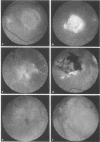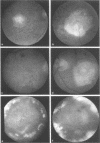Abstract
AIMS/BACKGROUND--A previous study has shown that in age-related macular degeneration a high degree of concordance of disciform scar size occurs in the two eyes of any one patient. In a study of 35 patients with choroidal neovascular membrane who were treated with low dose ionising radiation to the macula of the affected eye, 11 were found to have bilateral disease. METHODS--The visual outcome and scar size and morphology in the two eyes of each of these patients were compared. RESULTS--In all radiotherapy treated eyes the appearance of the scar ranged from subtle subretinal pigmentary changes to dense subretinal fibrosis. By contrast all untreated fellow eyes showed marked subretinal scarring. Scars in radiotherapy treated eyes occupied an area that was approximately one third of that in untreated fellow eyes (3.8 mm2 v 11.7 mm2). Distance and near visual acuities in radiotherapy treated eyes were significantly better than that of untreated fellow eyes (p < 0.0033). Although untreated fellow eyes of necessity had longer follow up periods (64.5 months), the mean follow up time in treated eyes was 28 months by which time the disciform response is generally thought to have ceased evolving. CONCLUSION--This study has provided evidence in support of reduced scarring and maintenance of better central visual function in radiotherapy treated eyes when compared with untreated fellow eyes.
Full text
PDF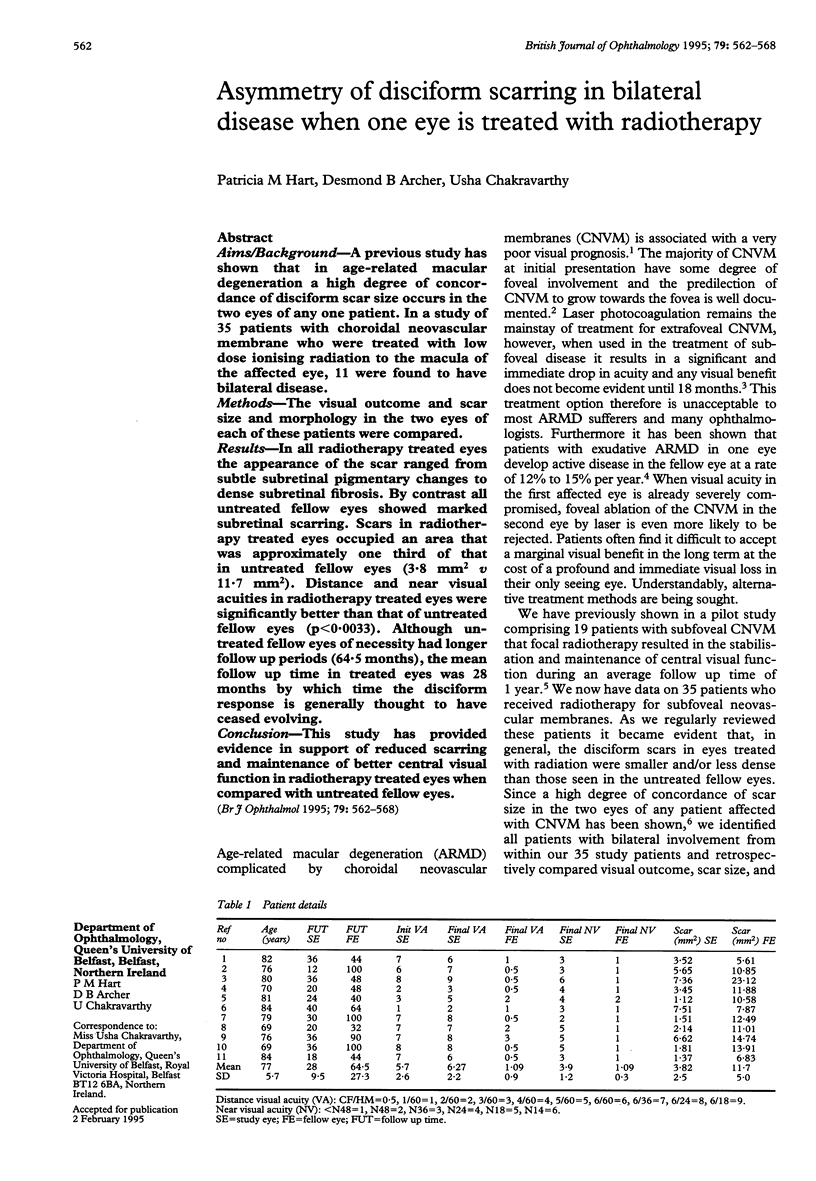
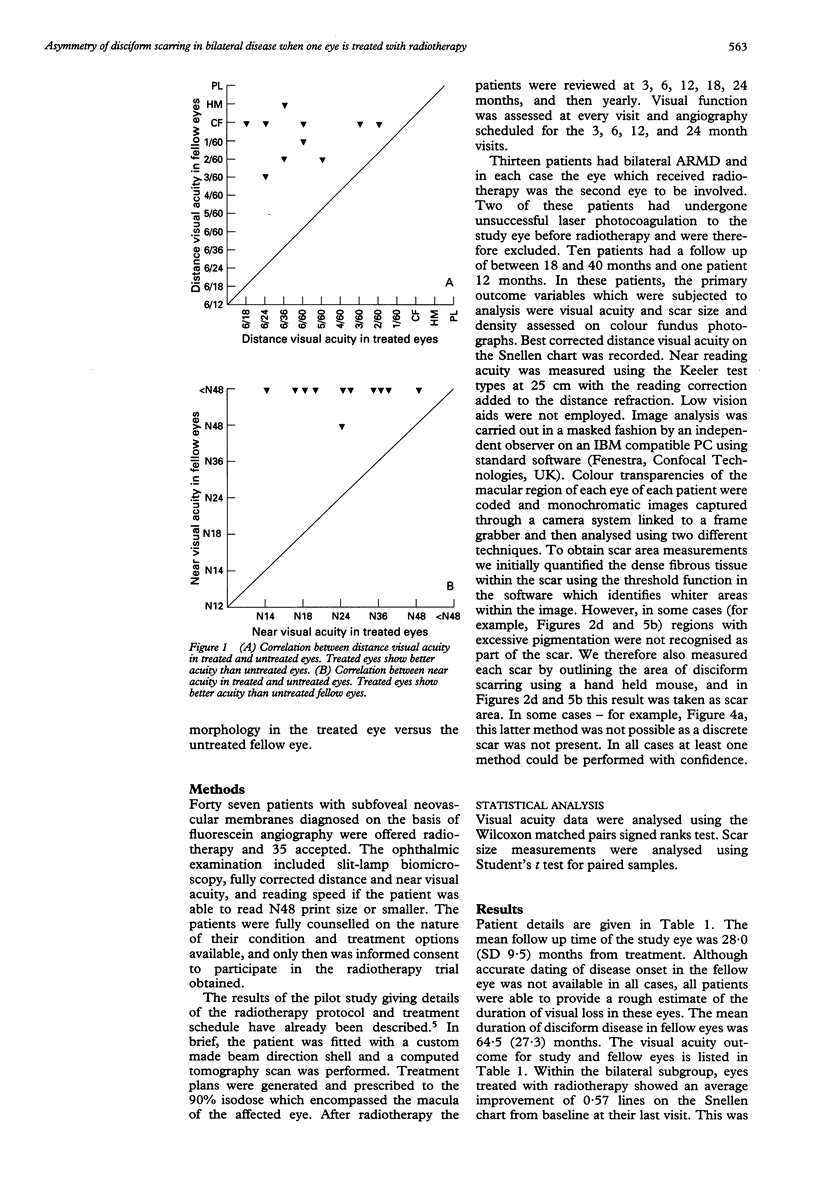

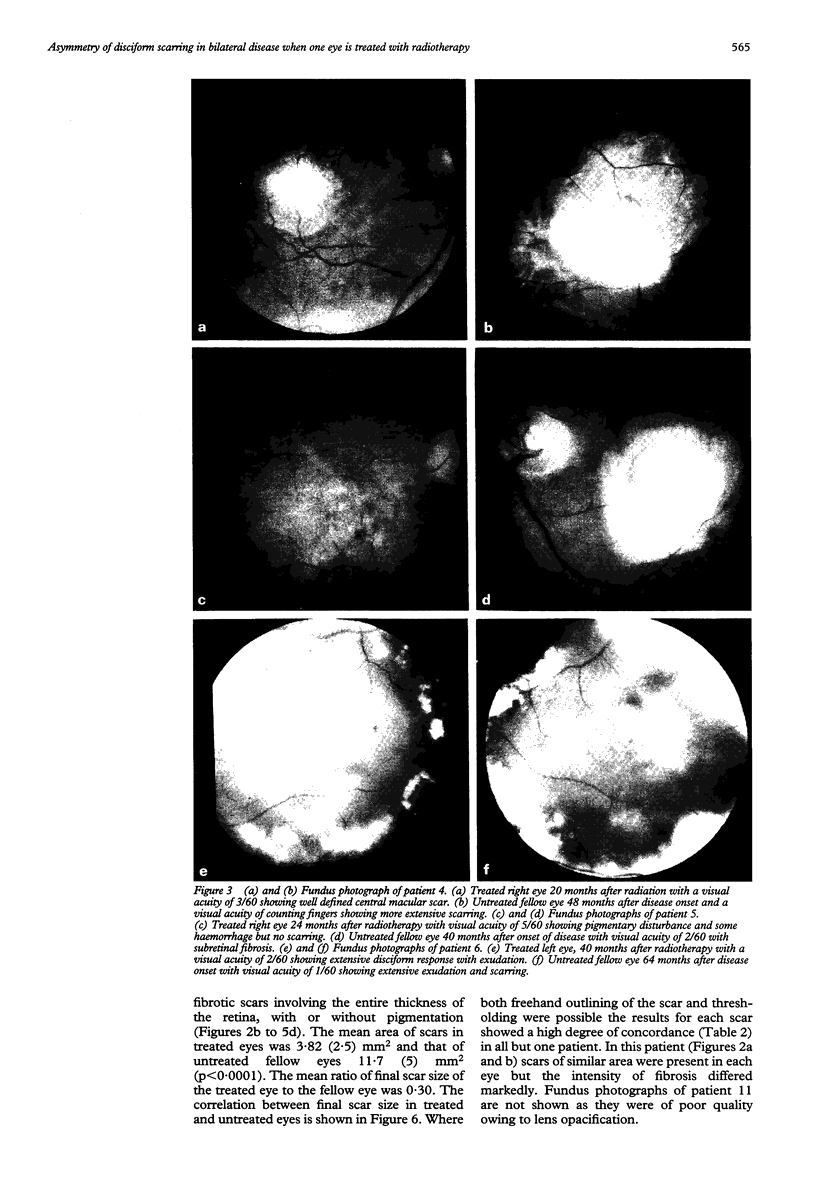
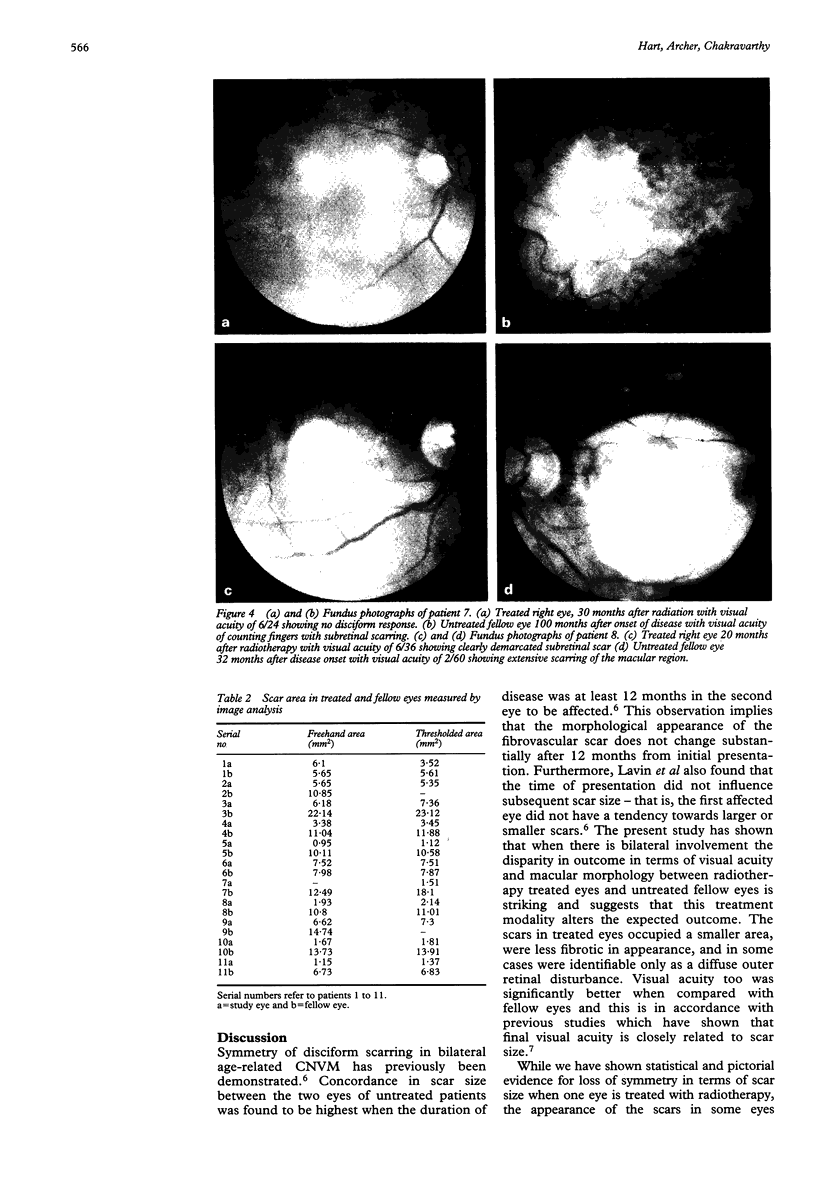
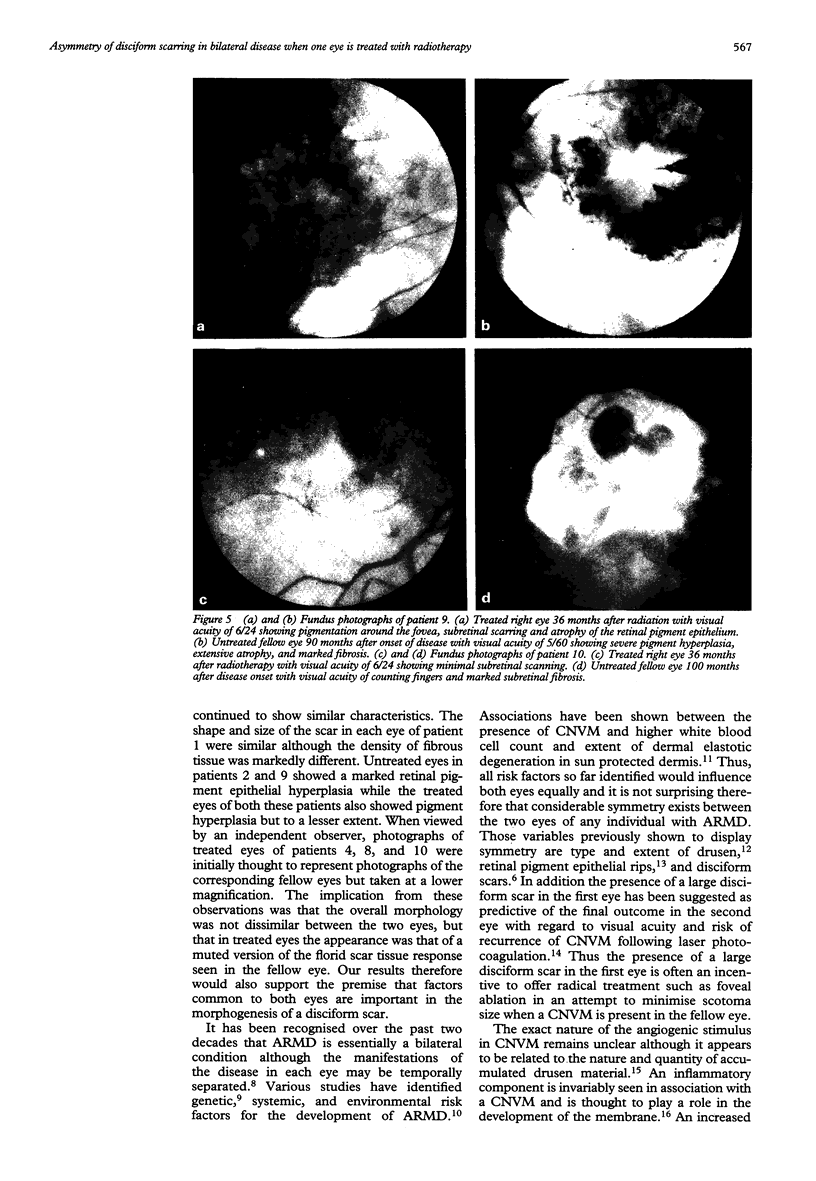
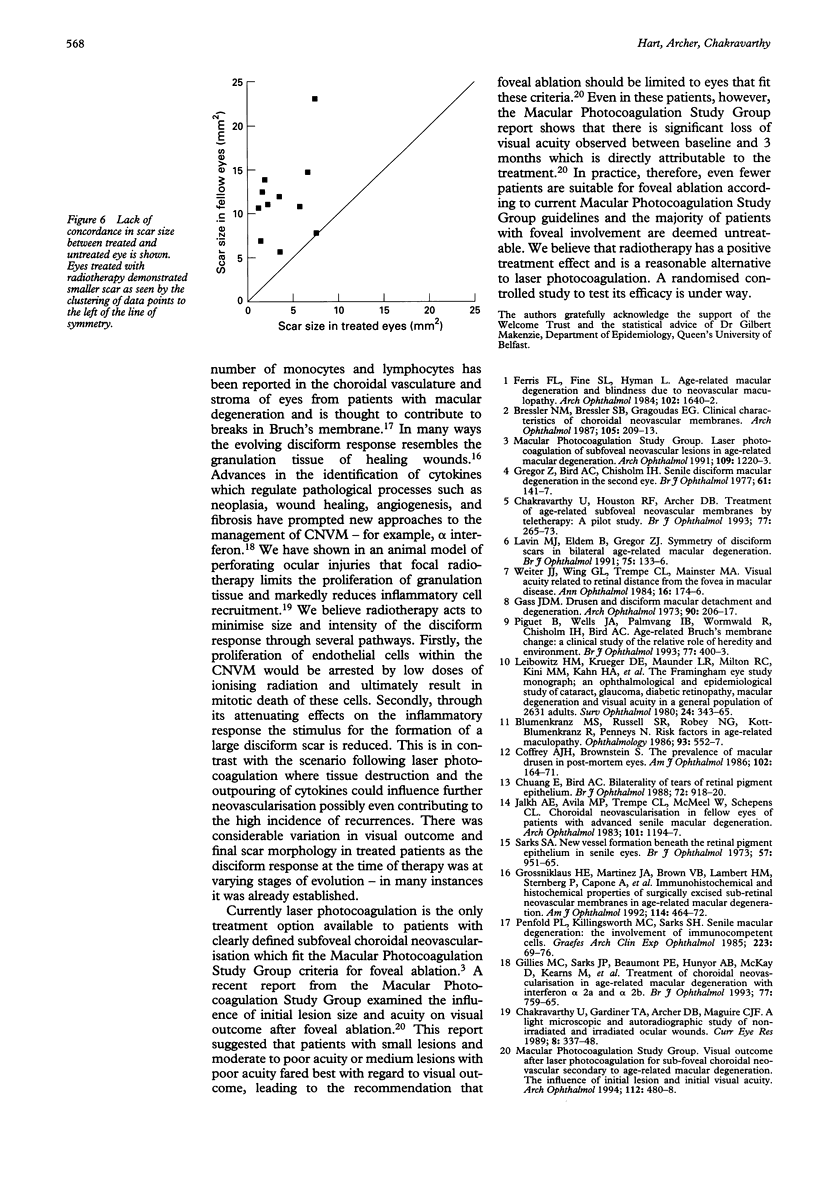
Images in this article
Selected References
These references are in PubMed. This may not be the complete list of references from this article.
- Blumenkranz M. S., Russell S. R., Robey M. G., Kott-Blumenkranz R., Penneys N. Risk factors in age-related maculopathy complicated by choroidal neovascularization. Ophthalmology. 1986 May;93(5):552–558. doi: 10.1016/s0161-6420(86)33702-3. [DOI] [PubMed] [Google Scholar]
- Bressler N. M., Bressler S. B., Gragoudas E. S. Clinical characteristics of choroidal neovascular membranes. Arch Ophthalmol. 1987 Feb;105(2):209–213. doi: 10.1001/archopht.1987.01060020063030. [DOI] [PubMed] [Google Scholar]
- Chakravarthy U., Gardiner T. A., Archer D. B., Maguire C. J. A light microscopic and autoradiographic study of non-irradiated and irradiated ocular wounds. Curr Eye Res. 1989 Apr;8(4):337–348. doi: 10.3109/02713688908996381. [DOI] [PubMed] [Google Scholar]
- Chakravarthy U., Houston R. F., Archer D. B. Treatment of age-related subfoveal neovascular membranes by teletherapy: a pilot study. Br J Ophthalmol. 1993 May;77(5):265–273. doi: 10.1136/bjo.77.5.265. [DOI] [PMC free article] [PubMed] [Google Scholar]
- Chuang E. L., Bird A. C. Bilaterality of tears of the retinal pigment epithelium. Br J Ophthalmol. 1988 Dec;72(12):918–920. doi: 10.1136/bjo.72.12.918. [DOI] [PMC free article] [PubMed] [Google Scholar]
- Coffey A. J., Brownstein S. The prevalence of macular drusen in postmortem eyes. Am J Ophthalmol. 1986 Aug 15;102(2):164–171. doi: 10.1016/0002-9394(86)90138-8. [DOI] [PubMed] [Google Scholar]
- Ferris F. L., 3rd, Fine S. L., Hyman L. Age-related macular degeneration and blindness due to neovascular maculopathy. Arch Ophthalmol. 1984 Nov;102(11):1640–1642. doi: 10.1001/archopht.1984.01040031330019. [DOI] [PubMed] [Google Scholar]
- Gass J. D. Drusen and disciform macular detachment and degeneration. Arch Ophthalmol. 1973 Sep;90(3):206–217. doi: 10.1001/archopht.1973.01000050208006. [DOI] [PubMed] [Google Scholar]
- Gillies M. C., Sarks J. P., Beaumont P. E., Hunyor A. B., McKay D., Kearns M., McClusky P. J., Sarks S. H. Treatment of choroidal neovascularisation in age-related macular degeneration with interferon alfa-2a and alfa-2b. Br J Ophthalmol. 1993 Dec;77(12):759–765. doi: 10.1136/bjo.77.12.759. [DOI] [PMC free article] [PubMed] [Google Scholar]
- Gregor Z., Bird A. C., Chisholm I. H. Senile disciform macular degeneration in the second eye. Br J Ophthalmol. 1977 Feb;61(2):141–147. doi: 10.1136/bjo.61.2.141. [DOI] [PMC free article] [PubMed] [Google Scholar]
- Grossniklaus H. E., Martinez J. A., Brown V. B., Lambert H. M., Sternberg P., Jr, Capone A., Jr, Aaberg T. M., Lopez P. F. Immunohistochemical and histochemical properties of surgically excised subretinal neovascular membranes in age-related macular degeneration. Am J Ophthalmol. 1992 Oct 15;114(4):464–472. doi: 10.1016/s0002-9394(14)71859-8. [DOI] [PubMed] [Google Scholar]
- Jalkh A. E., Avila M. P., Trempe C. L., McMeel J. W., Schepens C. L. Choroidal neovascularization in fellow eyes of patients with advanced senile macular degeneration. Role of laser photocoagulation. Arch Ophthalmol. 1983 Aug;101(8):1194–1197. doi: 10.1001/archopht.1983.01040020196004. [DOI] [PubMed] [Google Scholar]
- Lavin M. J., Eldem B., Gregor Z. J. Symmetry of disciform scars in bilateral age-related macular degeneration. Br J Ophthalmol. 1991 Mar;75(3):133–136. doi: 10.1136/bjo.75.3.133. [DOI] [PMC free article] [PubMed] [Google Scholar]
- Penfold P. L., Killingsworth M. C., Sarks S. H. Senile macular degeneration: the involvement of immunocompetent cells. Graefes Arch Clin Exp Ophthalmol. 1985;223(2):69–76. doi: 10.1007/BF02150948. [DOI] [PubMed] [Google Scholar]
- Piguet B., Wells J. A., Palmvang I. B., Wormald R., Chisholm I. H., Bird A. C. Age-related Bruch's membrane change: a clinical study of the relative role of heredity and environment. Br J Ophthalmol. 1993 Jul;77(7):400–403. doi: 10.1136/bjo.77.7.400. [DOI] [PMC free article] [PubMed] [Google Scholar]
- Sarks S. H. New vessel formation beneath the retinal pigment epithelium in senile eyes. Br J Ophthalmol. 1973 Dec;57(12):951–965. doi: 10.1136/bjo.57.12.951. [DOI] [PMC free article] [PubMed] [Google Scholar]
- Weiter J. J., Wing G. L., Trempe C. L., Mainster M. A. Visual acuity related to retinal distance from the fovea in macular disease. Ann Ophthalmol. 1984 Feb;16(2):174–176. [PubMed] [Google Scholar]



